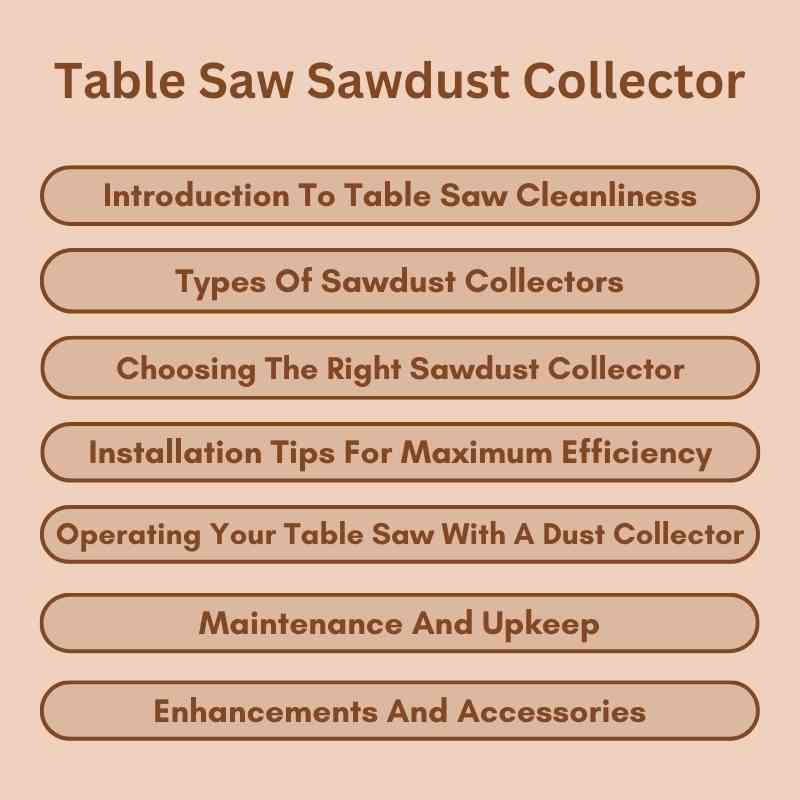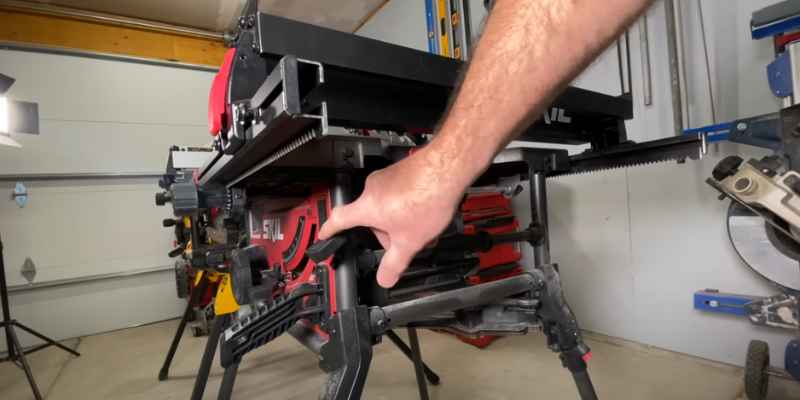A table saw sawdust collector efficiently captures wood debris produced while cutting. This tool helps maintain a clean workspace and improves air quality.
A table saw is a vital tool for woodworkers, but it generates a significant amount of sawdust. This sawdust can create an unsafe work environment, cluttering the space and causing health issues. Investing in a sawdust collector enhances productivity by keeping the area tidy.
It also prevents the fine particles from becoming airborne, which can lead to respiratory problems over time. Various types of sawdust collectors are available, including bag-style and cyclone models. Choosing the right one depends on your workshop’s size and your specific needs. A well-chosen collector not only simplifies cleanup but also extends the life of your tools by reducing wear from dust accumulation.
Introduction To Table Saw Cleanliness
Keeping your table saw clean is vital for safety and efficiency. Sawdust can pile up quickly, creating hazards. Proper sawdust management enhances your workspace and improves performance. A tidy area helps you focus and work effectively.
Importance Of Sawdust Management
Managing sawdust is crucial for several reasons:
- Safety: Excess sawdust can cause slips and falls.
- Equipment Longevity: Built-up dust can damage your tools.
- Air Quality: Sawdust can affect your breathing.
- Visibility: A clean area helps you see your project clearly.
Effective sawdust management leads to a safer and more productive workspace.
Benefits Of A Clean Workspace
A clean workspace offers many advantages:
- Improved Focus: Less clutter means better concentration.
- Increased Efficiency: Find tools and materials quickly.
- Enhanced Safety: Reduces the risk of accidents.
- Professional Appearance: Impress clients and colleagues.
Regular cleaning and effective sawdust collection can transform your work environment.
| Benefit | Description |
|---|---|
| Improved Focus | Less clutter helps you concentrate better. |
| Increased Efficiency | Quick access to tools saves time. |
| Enhanced Safety | Fewer hazards lead to fewer accidents. |
| Professional Appearance | A clean space impresses others. |
Investing in a sawdust collector enhances cleanliness. Enjoy the benefits of a well-maintained workspace.

Types Of Sawdust Collectors
Choosing the right sawdust collector is crucial for clean woodworking. Different types offer unique benefits. This section explores three popular types: Shop Vacuums, Dust Collection Systems, and Integrated Collection Features.
Shop Vacuums
Shop vacuums are versatile and easy to use. They work well for small projects. Here are some key points about shop vacuums:
- Portability: Easy to move around the workshop.
- Affordability: Generally less expensive than larger systems.
- Power: Can handle small to medium debris.
- Attachments: Various attachments available for different tasks.
Dust Collection Systems
Dust collection systems offer powerful performance. They are ideal for larger workshops. Here’s what you should know:
| Feature | Description |
|---|---|
| Capacity | Can collect large amounts of sawdust. |
| Efficiency | Removes dust from the air effectively. |
| Setup | May require permanent installation. |
| Cost | Higher investment compared to shop vacuums. |
Integrated Collection Features
Some table saws come with built-in dust collection. This feature simplifies cleanup. Here are some advantages:
- Space-saving: Reduces clutter in your workshop.
- Convenience: Easy to connect and operate.
- Efficiency: Optimizes dust collection while cutting.
- Less Noise: Often quieter than external systems.
Choosing The Right Sawdust Collector
Finding the best sawdust collector for your table saw is essential. A good collector keeps your workspace clean. It improves safety and efficiency. Evaluate your needs, compare models, and consider your budget.
Assessing Your Needs
Identify your specific requirements. Think about:
- The size of your workshop
- The type of wood you cut
- How often you use your table saw
For small workshops, a compact collector may suffice. Larger shops may need a more powerful system. Check the cubic feet per minute (CFM) rating. Higher CFM means better dust collection.
Comparing Collector Models
Different models offer various features. Key aspects to compare include:
| Feature | Bag Collector | Cyclone Collector |
|---|---|---|
| Cost | Lower | Higher |
| Efficiency | Good | Excellent |
| Maintenance | Frequent | Less frequent |
| Portability | More portable | Less portable |
Choose a model that fits your needs. Read reviews and check specifications.
Budget Considerations
Your budget plays a big role in your choice. Consider these points:
- Prices range widely from $100 to $1,500.
- Factor in long-term costs, like filters and bags.
- Look for warranties and customer support.
Investing in a quality sawdust collector pays off over time. A good model lasts longer and works better.
Installation Tips For Maximum Efficiency
Proper installation of your table saw sawdust collector boosts performance. It helps in keeping your workspace clean. Follow these tips for the best results.
Proper Placement
Placement of your sawdust collector is crucial. Here are some tips:
- Close to the Table Saw: Place the collector near the saw. This reduces the distance for sawdust to travel.
- Level Surface: Ensure the collector sits on a flat surface. This prevents tipping and ensures stability.
- Avoid Obstacles: Keep the area clear. Obstacles can block airflow and reduce efficiency.
Securing Connections
Secure connections are vital for effective dust collection. Follow these steps:
- Use Duct Tape: Seal any gaps between the collector and hoses.
- Check Hose Clamps: Tighten all hose clamps to prevent leaks.
- Inspect Joints: Ensure all joints are snug. Loose connections can let dust escape.
Testing Airflow
Testing airflow helps ensure your system works well. Here’s how to do it:
- Turn on the Collector: Power up the sawdust collector.
- Check for Air Movement: Use a piece of tissue. Hold it near the hoses.
- Observe: The tissue should move towards the collector. This indicates good airflow.
Regular checks keep your system running efficiently. Monitor airflow to ensure optimal performance.
Operating Your Table Saw With A Dust Collector
Using a dust collector with your table saw enhances safety and cleanliness. It captures sawdust effectively, keeping your workspace tidy. A cleaner environment boosts your focus and productivity.
Safety First
Safety is crucial when operating a table saw. Dust can obscure your view and create hazards. Follow these safety tips:
- Wear safety goggles to protect your eyes.
- Use a dust mask to avoid inhaling particles.
- Keep the area well-lit for better visibility.
- Ensure the dust collector is properly connected before starting.
Regularly check the dust collector for clogs. Blockages can reduce efficiency and create risks. Always prioritize safety over speed.
Maintaining Consistent Use
For optimal performance, use the dust collector consistently. Here’s how to maintain it:
- Turn on the dust collector before starting your cut.
- Keep the hose clear of any bends or kinks.
- Regularly empty the dust bag or container.
- Inspect the filters for dirt buildup.
Consistent use prevents excessive dust buildup. It helps keep your work area safe and clean.
Adjusting For Different Materials
Different materials produce varying amounts of dust. Adjust your setup accordingly:
| Material | Dust Production | Adjustment Needed |
|---|---|---|
| Softwood | Moderate | Standard settings |
| Hardwood | High | Increase suction power |
| Plywood | Low | Standard settings |
| MDF | Very High | Increase suction power |
Adjustments enhance dust collection efficiency. Always monitor your setup for best results.
Maintenance And Upkeep
Proper maintenance ensures your table saw sawdust collector works efficiently. Regular upkeep saves money and time. Follow these steps to keep your collector in top shape.
Regular Cleaning Routines
Cleaning is crucial for optimal performance. Set a routine for cleaning your sawdust collector:
- Empty the collection bag or bin after each use.
- Wipe down the exterior surfaces.
- Check for dust buildup in hard-to-reach areas.
Use a soft brush or compressed air to remove dust. This prevents clogs and improves airflow.
Replacing Filters And Bags
Filters and bags wear out over time. Regular replacement keeps the system efficient. Follow these tips:
- Check filters monthly for damage.
- Replace filters every 6 months.
- Use OEM bags for best results.
Always refer to the manufacturer’s guidelines for specific recommendations.
Troubleshooting Common Issues
Encountering problems is common. Here are steps to troubleshoot:
| Issue | Solution |
|---|---|
| Weak suction | Check for clogs in the hose. |
| Filter not fitting | Ensure you have the correct size filter. |
| Noisy operation | Inspect for loose parts or debris. |
Addressing these issues promptly keeps your sawdust collector running smoothly.
Enhancements And Accessories
Enhancing your table saw’s performance is easy with the right accessories. These upgrades improve dust collection and keep your workspace clean. Let’s explore some must-have enhancements.
Upgraded Filters
Upgraded filters make a big difference in dust collection. They trap smaller particles and improve air quality. Consider these filter options:
- HEPA Filters: Capture 99.97% of dust particles.
- Cartridge Filters: Easy to clean and maintain.
- Bag Filters: Affordable and simple to replace.
Choose filters based on your workshop needs. Better filters mean cleaner air and less cleanup.
Dust Separator Add-ons
Dust separator add-ons enhance your saw’s dust collection. They work by separating larger debris before it reaches the main collector. This reduces clogging and increases efficiency.
| Type | Benefits |
|---|---|
| Cyclone Separators | Very effective at removing fine dust. |
| Thien Baffle | Simple design, low cost, easy to build. |
| DIY Separators | Customizable to fit your specific needs. |
Adding a dust separator reduces wear on your collector. It saves time spent on emptying and cleaning.
Custom Fit Hoses
Custom fit hoses improve airflow and dust collection efficiency. Standard hoses may not fit perfectly. Consider these options:
- Flexible Hoses: Bend and shape easily around your workspace.
- Rigid Hoses: Provide a strong connection and reduce leaks.
- Adapters: Connect different sized ports securely.
Custom hoses maintain strong airflow. They help keep your workspace cleaner and safer.
The Environmental Impact Of Sawdust Disposal
Sawdust disposal can harm the environment. Many woodworkers generate large amounts of sawdust. If not managed properly, this waste can pollute land and waterways.
Sawdust can release harmful chemicals into the soil and air. It contributes to landfill overflow. Understanding how to manage this waste is crucial.
Sawdust Recycling And Reuse
Recycling sawdust is a smart choice. Here are some ways to recycle or reuse sawdust:
- Animal Bedding: Sawdust provides a soft bedding material for pets.
- Composting: It adds carbon to compost piles, enhancing soil health.
- Mulch: Sawdust can help retain moisture in gardens.
- Fuel Pellets: Sawdust can be compressed into eco-friendly fuel pellets.
Many companies accept sawdust for recycling. This reduces waste and benefits the environment.
Responsible Disposal Methods
For sawdust disposal, always choose responsible methods. Here are some effective options:
- Local Recycling Centers: Check for facilities that accept sawdust.
- Woodworking Schools: Donate surplus sawdust for educational projects.
- Community Gardens: Offer sawdust to local gardens for mulching.
- Burning: If allowed, burn sawdust in a controlled environment.
These methods help minimize environmental impact. Proper disposal keeps our planet cleaner.
Case Studies: Successful Sawdust Management
Effective sawdust management is essential for any woodworking operation. It improves safety, boosts efficiency, and keeps the workspace tidy. Let’s explore successful case studies across different settings.
Professional Workshops
Many professional workshops face challenges with sawdust accumulation. Successful workshops implement robust sawdust collectors. Here are key strategies:
- Centralized Collection Systems: Large collectors pull sawdust from multiple machines.
- Regular Maintenance: Frequent checks keep systems running smoothly.
- Employee Training: Staff learn best practices for using collectors.
| Workshop | Sawdust Collection Method | Results |
|---|---|---|
| ABC Woodworks | Centralized System | 70% reduction in sawdust |
| XYZ Carpentry | Portable Collectors | Improved air quality |
DIY Enthusiasts
DIY enthusiasts also benefit from effective sawdust management. Small spaces require innovative solutions. Here are popular methods:
- Shop Vacuums: Easy to set up and use.
- Bags and Bins: Simple storage options for sawdust.
- Homemade Collectors: Creative designs save money.
Many DIYers report cleaner work areas and less respiratory irritation. They find that small changes lead to big improvements.
Industrial Applications
In industrial settings, sawdust management is crucial. Companies implement advanced systems to handle large volumes. Here are effective strategies:
- High-Efficiency Collectors: Designed for heavy-duty use.
- Automated Systems: Reduce manual labor and errors.
- Recycling Programs: Transform sawdust into usable products.
| Company | Sawdust Management System | Outcome |
|---|---|---|
| WoodTech Inc. | Automated High-Efficiency Collectors | 80% sawdust reduction |
| Furniture Co. | Recycling Program | Turned waste into profit |
Conclusion: Embracing Cleanliness In Woodworking
Cleanliness in woodworking enhances safety and boosts efficiency. A well-maintained shop promotes creativity and focus. Using a Table Saw Sawdust Collector keeps your workspace tidy and organized.
Recap Of Key Takeaways
- Sawdust management is crucial for a safe workspace.
- Investing in a quality sawdust collector improves air quality.
- Regular maintenance of tools prevents dust buildup.
- Clean workspaces lead to increased productivity.
The Journey Towards A Cleaner Shop
Creating a cleaner shop requires effort and dedication. Start by evaluating your current setup. Identify the sources of dust and debris.
- Choose the right sawdust collector for your needs.
- Set up a dust collection system with your table saw.
- Keep your workspace organized and clutter-free.
- Regularly empty and clean the sawdust collector.
Remember to involve everyone in the shop. Teamwork fosters a culture of cleanliness. A cleaner workspace feels more inviting and enjoyable.
| Benefits of a Clean Shop | Impact on Woodworking |
|---|---|
| Improved Safety | Reduces slip hazards and injuries. |
| Enhanced Focus | Minimizes distractions from clutter. |
| Better Air Quality | Reduces respiratory issues. |
| Increased Productivity | Allows for quicker project completion. |
Embrace cleanliness as a core value in woodworking. Your efforts will lead to a more efficient and enjoyable woodworking experience.

Frequently Asked Questions
What Is A Table Saw Dust Collector?
A table saw dust collector is a device designed to capture sawdust and debris produced while cutting wood. It connects to the saw, ensuring a cleaner workspace. By minimizing dust, it enhances visibility and reduces health risks associated with inhaling fine particles.
It’s essential for any serious woodworker.
How Does A Sawdust Collector Work?
A sawdust collector works by creating suction that draws in sawdust from the table saw. It uses a fan or blower to generate airflow, directing debris into a storage bag or bin. This process keeps the work area cleaner and improves the efficiency of cutting tasks.
Proper maintenance ensures optimal performance.
Why Do I Need A Dust Collector?
You need a dust collector to maintain a clean and safe workspace. Excess sawdust can pose health risks and create hazards. A dust collector improves air quality and visibility, allowing for more precise cuts. It also protects your equipment by preventing buildup in machinery.
Can I Use A Shop Vac Instead?
Yes, you can use a shop vac as a dust collector for your table saw. However, it may not capture all fine particles effectively. Shop vacs are portable and affordable, making them a popular choice. For better results, consider using a dedicated dust collector designed for woodworking.
Conclusion
Choosing the right table saw sawdust collector is essential for a cleaner workspace. A good collector improves safety and efficiency. By investing in quality equipment, you enhance your woodworking experience. Remember to consider factors like size and power. Keep your shop tidy and enjoy your projects to the fullest!

